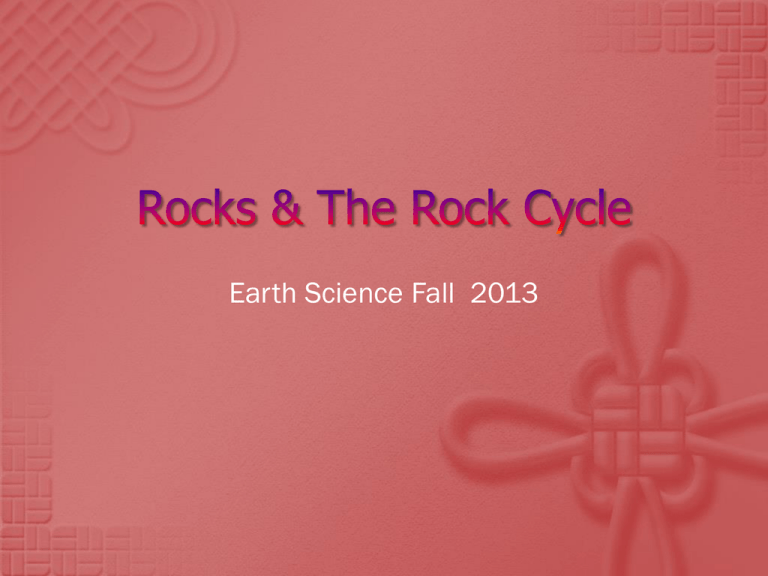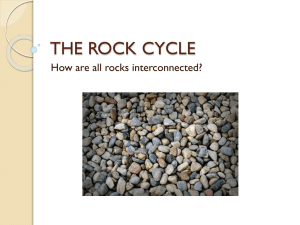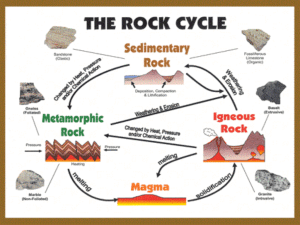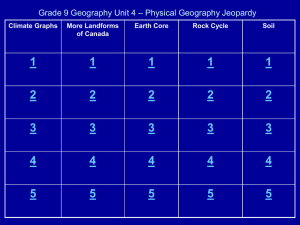Rocks & The Rock Cycle
advertisement

Earth Science Fall 2013 Batholith- intrusive formation with at least a surface exposure of 100 square kilometers and reaching a depth of thousands of meters Breccia- elastic sedimentary rock composed of angular fragments Cementation- process in which dissolved minerals left by water passing through sediments bind sediments together Chemical sedimentary rock- rock formed from minerals that precipitate out of water Clastic sedimentary rock- rock made up of fragments from pre-existing rocks Compaction- process in which air and water are squeezed out of sediments, resulting in the formation of sedimentary rock Concretion- nodule of rock with a different composition from that of the main rock body Conglomerate- sedimentary rock composed of rounded gravel or pebbles cemented together by minerals Contact metamorphism- change in the structure and mineral composition of rock surrounding an igneous intrusion Dike- igneous intrusion that cuts across rock layers Evaporites- sedimentary rocks formed from minerals left after water evaporates Extrusive igneous rock- rock formed from molten lava that hardens on the earth’s surface Foliated- describing metamorphic rock with parallel bands Fossil- trace or remains of a plant or an animal in sedimentary rock Igneous rocks- rock formed from cooled and hardened magma Intrusive igneous rock- rocks formed from the cooling of magma beneath the earth’s surface Laccolith- flat-bottomed intrusion that pushes overlying rock layers into an arc Lava Plateau- raised flat-topped area made of layers of hardened lava Metamorphic rock- rock formed from other rocks as a result of intense heat, pressure, and chemical processes Metamorphism- changing of one type of rock to another by heat, pressure, and chemical processes Nonfoliated- describing a metamorphic rock without parallel bands Organic sedimentary rock- rock formed from the remains of organisms Porphyritic- describing an igneous rock composed of both large and small crystals Regional metamorphism- metamorphism that affects rocks over large areas during period of tectonic activity Rock cycle- series of processes in which rock changes from one type to another Sediment- fragments that result from the breaking of rocks, minerals, and organic matter Sedimentary rock- rock formed from hardened deposits of sediment Sill- sheet of hardened magma that forms between and parallel to layers of rock Stock- igneous intrusion with an area less than 100 square kilometers Stratification- layering of sedimentary rock Volcanic neck- solidified central vent of a volcano Magma from the earth’s interior is the parent material for all rocks From the time magma cools & hardens at or near the surface of the earth, the resulting rock begins to change. Geologists have classified rocks into 3 major types based on the way the rocks are formed. 3 major rock types Igneous rock Sedimentary rock Metamorphic rock 2 groups of igneous rocks that are classified according to where molten rock cools and hardens Intrusive igneous rocks Magma cools below the crust Extrusive igneous rocks Rapid cooling of lava on the earths surface Extrusive & intrusive igneous rocks differ mainly in their sized of crystalline grain and is known as texture Texture is determine by the cooling rate of the magma or lava that formed the rock Slow loss of heat allows minerals to form large, well-developed crystalline grains Coarse-grained texture Ex: granite Rapid loss of heat does not allow time for large crystalline grains to form, this produces fine-grained rock Ex: basalt Oceanic crust is made mostly of basalt Lava or magma cools slowly at first & then rapidly as it near the earth’s surface, relatively large crystals embedded within a mass of smaller ones Porphyritic Highly viscous, silica-rich magma cools rapidly and no crystals form Ex: obsidian Magma that contains large amounts of dissolved gases hardens, the gases become trapped in the rock and produces rock full of holes Ex: pumice Determined by the chemical composition of the magma from which the rock develops Divided into 3 families Felsic Intermediate Mafic Felsic rocks Formed from magmas that are high in silica Have light coloring of their main mineral components, orthoclase feldspar & quartz May also contain plagioclase feldspar, biotite mica, & muscovite mica Ex: granite , rhyolite, obsidian Obsidian may be black, blue, or red depending on its chemical composition Mafic rocks Form from magmas that are low in silica but rich in iron and magnesium Also can include ferromagnesian minerals making them dark in color Ex: basalt , gabbro Intermediate Rocks Medium colored Contain minerals such as plagioclase feldspar, hornblende, pyroxene minerals, biotite mica Contain less quartz than the felsic family Ex: diorite , andesite Intrusions Largest of all intrusions are batholiths Form cores of several major mountain ranges like the Sierra Nevada range in CA & the Coast Range in BC A stock is similar to a batholith only much smaller Laccoliths form when magma flows between rock layers and spread upward sometimes pushing the overlying rock into an arc Frequently found in groups Ex: Black Hills Sills form when a sheet of magma flows between layers of rock and hardens, it does not cause the arcing like a laccolith Lie parallel to rock layers & vary in thickness from a few cm to hundreds of meters Ex: Big Bend National Park in Texas When magma forces its way through rock layers by following existing vertical fractures or by creating new ones and solidifies is called a dike Common in areas of volcanic activity Extrusions A volcano is a cone of extrusive rock surrounding a central vent, when a volcano stops erupting for a long period the cone gradually wears away and the solidified central vent is left, this is called a volcanic neck A lava plateau develops from lava that flows out of long cracks in the earth’s surface Sedimentary rock is made up of accumulations of various types of sediments Compaction & cementation are 2 processes that form sedimentary rocks Sedimentary rocks are classified according to the kind & size of sediments that form them Clastic sedimentary rock is made up of rock fragments carried away from their source by water, wind, or ice & left as deposits elsewhere Chemical sedimentary rock forms from minerals that precipitate from water Organic sedimentary rock forms from the remains of organisms Classified by the size of the sediments they contain Conglomerate- rock composed of rounded gravel sized fragments or pebbles Breccia- rock made of rock fragments that are angular & have sharp corners In both conglomerate and breccia the fragments can be easily viewed Sandstones- rocks that are made up of sand sized grains that have been cemented together Quartz is the major component Many have pores between the sand grains through which liquids can move Shale- rock that consists of clay-sized particles cemented and compacted under pressure Usually pressed into flat layers that will easily split apart Form from dissolved minerals that were once dissolved in water Evaporites- rocks formed from the dissolved minerals left behind from water evaporating Ex: gypsum & halite Bonneville Salt Flats, Utah Rocks formed from the remains of living things Ex: coal & some limestones Coal forms from decayed plant remains that are buried and compacted into matter that is mostly carbon Organic limestones- from marine animal shells Chalk- made up of tiny, one-celled marine organisms Originally forms as mud on the ocean floor Ex: white cliffs of Dover, England Stratification Layering of sedimentary rock that occurs when there is a change in the kind of sediment being deposited Type of deposit varies for many reasons Layers vary in thickness Grade bedding- occurs when various sizes and kinds of materials are deposited within one layer Ripple Marks & Mud Cracks Ripple marks are formed by the action of wind or water on sand Mud cracks result when muddy deposits dry and shrink; the shrinking causes the dried mud to crack Fossils Remains or traces of ancient plants and animals Usually preserved in sedimentary rock Concretions Lumps of rock with a different composition from the main rock body Form when minerals precipitated from solutions build up around an existing rock particle Groundwater sometimes deposits dissolved quartz or calcite inside cavities of sedimentary rock where it crystallizes and forms a geode. Metamorphism is the changing of one type of rock to another by heat, pressure, and chemical process Most forms deep beneath the surface of the Earth All is formed from existing igneous, sedimentary, or metamorphic rock During metamorphism certain minerals change into other minerals; some minerals change in size or shape or separate into parallel bands that give the rock a layered appearance 2 types of metamorphism occur in the earth’s crust Contact metamorphism occurs when rocks come into direct contact with or very near magma Regional metamorphism occurs due to heat and pressure created by tectonic activity Most metamorphic rock is formed by regional metamorphism, however rocks formed by contact metamorphism can also be found where regional metamorphism has occurred. Classified according to their texture into two categories Foliated- have parallel bands of minerals Non-foliated- do not have parallel bands of minerals Foliated Rocks Form in 2 ways Extreme pressure may flatten the mineral crystals in the original rock & push them into parallel bands Minerals of different densities separate into bands, producing a series of alternating dark and light Ex: slate, schist, gneiss Slate- formed by pressure acting on shale Schist- formed when a greater amount of heat & pressure change slate into a coarser-grained rock Gneiss- greatly metamorphosed rock with bands of light and dark minerals Do not have bands of crystals Quartzite- forms when sandstone undergoes metamorphosis Heat & pressure cause the mineral grains to recrystallize so that the spaces between them disappear Marble- formed from the compression of limestone









